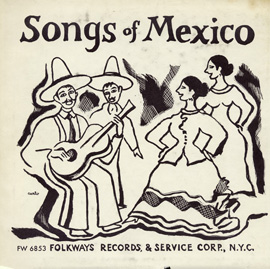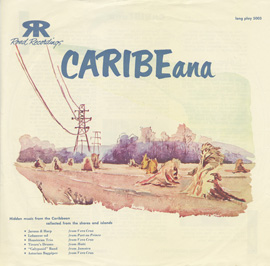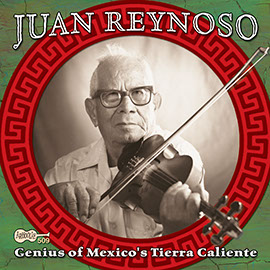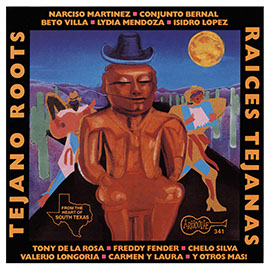Summary
Use lively recordings and videos from celebrated son jarocho performers José Gutiérrez & Los Hermanos Ochoa to explore regional Mexican folk music and culture. Discuss poetic structure in song lyrics. Translated lyrics improve Spanish language skills.
Suggested Grade Levels: 3-5, 6-8, 9-12
Country: Mexico
Region: Veracruz
Culture Group: Mexican
Genre: Son Jarocho
Instruments: Voice
Language: Spanish
Co-Curricular Areas: Spanish, Social Studies, Dance
National Standards: 1, 5, 6, 8, 9
Musical Knowledge/Skills:
Listening to (instruments, beat, meter); Spanish words and lyrics; Song Structure/ Singing (partial lyrics and full melodies); Dancing
General Knowledge/Skills:
Getting to know the culture of Mexico--its language, location, values; the migration of music, the importance of dance.
Material:
- Materials from Folkways:
- La Bamba: Sones Jarochos from Veracruz performed by José Gutiérrez & Los Hermanos Ochoa (SFW40505)—liner notes, English and Spanish lyrics
- "El Zapateado" from La Bamba: Sones Jarochos from Veracruz performed by José Gutiérrez & Los Hermanos Ochoa (SFW40505)
- "El Pájaro Cu" (The Coo Bird) from La Bamba: Sones Jarochos from Veracruz performed by José Gutiérrez & Los Hermanos Ochoa (SFW40505)
- Videos of "La Bamba" and "Balajú"
Instruments: hands (clapping); voice; feet (dancing); cajon (wooden box)
Other Materials: map of Veracruz; Photos/videos of the culture, people, and location; photos of instruments or actual instruments; other videos found in library
Experiences: Watch videos of "La Bamba" and "Balaju"
Lesson Segment :
- "El Zapateado"
- "El Pájaro Cu (The Coo Bird)"

“El Zapateado”
from La Bamba: Sones Jarochos from Veracruz (2003) | SFW40505
“El Pájaro Cu (The Coo Bird)”
1. "El Zapateado"
- Listen to recording
- (a) Clap/Pat different patterns to 6/8 - (sesquialtera) Discuss meter/use rhythm sticks to tap out beats or dance steps
- (b) Move side to side to the downbeats
- Ask students if they hear what type of instruments are being used; explain instruments through pictures, video, or having the instruments present. Ask students what instruments are common in other music? What instruments are different? Is the dance used an instrument?
- Explain short history of Veracruz and son jarocho music and history of the folk music tradition (See liner notes and Grove Music Online for information)
- Explain the zapateado and show video of dances - rapid movement of the dancer's feet against the ground or a tarima (raised wooden platform) producing a percussive accompaniment normally performed during instrumental interludes so the singing is not drowned out. (See Grove Music Online)
- Explain type of dance (jarabe) - Example is the Mexican Hat Dance played in the video
- Departing from the popular well-known dance show another video of other dances of the jarabe and/or explore the history of the Mexican Hat Dance
- Explain meaning of the word jarabe - refers to "sweet syrup:" "Jarabe" is derived from the Arabic word "Xarab" which means mixture of herbs
- Trace the meaning of the word and song and figure out where is it today - riginating from Spain and developed in Mexico; Son jarochos influenced by African slaves (e.g. La Bamba); moved into mariachi music/popular Latin music; It is now present in the U.S. in folk dance troupes - professionally, in schools, and in popular music (e.g. Los Lobos - Album: Pistola y Corazon);
- Find popular son jarochos in popular music and in Mariachi music
- Hand out lyrics in Spanish and English; discuss the lyrics and meanings; dissect 10 - line stanzas (decimas) commonly sung in verses comprised with ten lines in a rhyme scheme - abbaaccddc, which develops a theme introduced by a quatrain (rhymed abab). Textual material may be set or improvised, religious or secular.
- Create own decimas in English or Spanish
2. "El Pájaro Cu" (The Coo Bird)
- Listen to recording
- (c) Clap/Pat different patterns to 6/8 - (sesquialtera) Discuss meter/use rhythm sticks to tap out beats
- (a) Learn dance move and practice with and without the music

- Ask students if they hear what type of instruments are being used; explain instruments through pictures, video, or having the instruments present; Ask students what instruments are common in other music?; What instruments are different?; Is the dance used an instrument?
- Explain the zapateado - rapid movement of the dancer's feet against the ground or a tarima (raised wooden platform) producing a percussive accompaniment normally performed during instrumental interludes so the singing is not drowned out - Grove Music Online); show video of dances
- Hand out lyrics in Spanish and English; discuss the lyrics and meanings; dissect 10 - line stanzas (decimas); Learn more about the poetic structure; try to create own lyrics using decimas in English and/or Spanish; try improvising
Extensions:
- Lesson easily can be tailored to age group; for older students with more in-depth talk about issues of musical migration. From where does a particular music originate, change, and adapt when it travels and is recreated in different genres, cultures, and locations? Trace songs through different musical genres.
- Listen to more music from the region. Find videos that explain the different dances and dance moves; go watch a traditional folk dance company; create dances and songs; learn more about the costumes
- Invite local musicians and dancers to come and conduct a lecture or demonstration.
- Obtain other instruments of the ensemble and learn simple bass parts of the Marímbola (Chord pattern can be used on bass Orff instruments or other bass instruments), Quijada, Cajon; Jarana, etc. Listen to recordings for instrumental and jarana strum patterns; create a cajon or tarima for use in practice or performance.

Son jarocho is the traditional rural music of Veracruz in the Gulf region of Mexico. The son includes coplas or stanzas sung by a "caller" who is accompanied by the hard-driving rhythms of musicians playing unique regional guitars and harp. Jarocho describes the people and culture of southern Veracruz. "La Bamba" is among the best known jarocho songs inside and outside Mexico. The version performed here by José Gutiérrez and Los Hermanos Ochoa showcases a lively harp solo by virtuoso Felipe Ochoa and the rhythmic plucking of the requinto jarocho guitar.
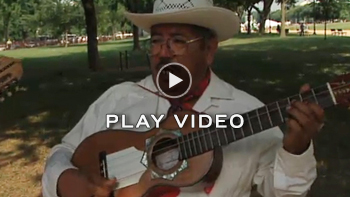
José Gutiérrez and the Ochoa brothers are among the most celebrated performers of the Mexican son jarocho tradition. Gutiérrez serves as the caller (pregonero), or lead singer, improvising verses in a high, clear, loud voice. Felipe Ochoa masters the arpa jarocha (harp) with an intensity that never lets up, and brother Marcos supplies the driving rhythm of the jarana, adding creative flourishes and abrupt stops that lift the others to a higher plane of performance. The three men have performed together throughout Europe and the Americas for the past two decades.



